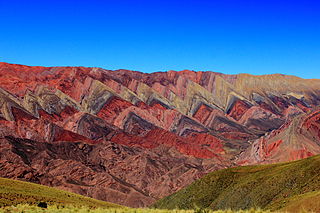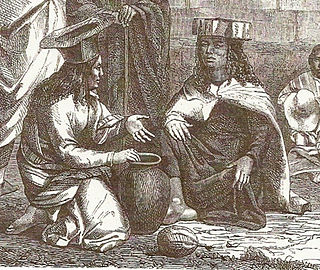
The llama is a domesticated South American camelid, widely used as a meat and pack animal by Andean cultures since the pre-Columbian era.

The Inca road system was the most extensive and advanced transportation system in pre-Columbian South America. It was about 40,000 kilometres (25,000 mi) long. The construction of the roads required a large expenditure of time and effort.

Jujuy is a province of Argentina, located in the extreme northwest of the country, at the borders with Chile and Bolivia. The only neighboring Argentine province is Salta to the east and south.

The guanaco is a camelid native to South America, closely related to the llama. Guanacos are one of two wild South American camelids; the other species is the vicuña, which lives at higher elevations.

The vicuña or vicuna is one of the two wild South American camelids, which live in the high alpine areas of the Andes; the other camelid is the guanaco, which lives at lower elevations. Vicuñas are relatives of the llama, and are now believed to be the wild ancestor of domesticated alpacas, which are raised for their coats. Vicuñas produce small amounts of extremely fine wool, which is very expensive because the animal can only be shorn every three years and has to be caught from the wild. When knitted together, the product of the vicuña's wool is very soft and warm. The Inca valued vicuñas highly for their wool, and it was against the law for anyone but royalty to wear vicuña garments; today, the vicuña is the national animal of Peru and appears on the Peruvian coat of arms.

Llameros are indigenous peasants who run llama caravans throughout the Andes of South America.

Uyuni is a city in the southwest of Bolivia.

Gerardo Zamora is an Argentine politician who has served as Governor of Santiago del Estero since 2017, and previously from 2005 to 2013. He is a member of the centrist Radical Civic Union (UCR).
Ven mi corazón te llama is a 1942 Argentine film directed by Manuel Romero during the Golden Age of Argentine cinema.
Cristian Ezequiel Llama is an Argentine football midfielder who plays for Italian Serie D club Akragas.

The Atacama people, also called Atacameño, are an Indigenous people from the Atacama Desert and altiplano region in the north of Chile and Argentina and southern Bolivia, mainly the Antofagasta Region.

Antofagasta de la Sierra is a village in Catamarca Province, Argentina. It is the head town of the Antofagasta de la Sierra Department.
The Capayán were an Indigenous people, now extinct, that lived in Argentine territory.

Lamini is a tribe of the subfamily Camelinae. It contains one extant genus with four species, all exclusively from South America: llamas, alpacas, vicuñas, and guanacos. The former two are domesticated species, while the latter two are only found in the wild. None display sexual dimorphism. The four species can interbreed and produce fertile offspring. Additionally, there are several extinct genera.

Apoyaco is a village and municipality in Catamarca Province in northwestern Argentina bordering Chle. The indigenous Atacama people live in this province and village. The village and region is home to lamini, alpaca and llama herding as well as farming pumpkins, zucchini, chili, beans, tobacco, melon, corn, potatoes, and quinoa.

Vicente Padula was an Argentine film actor. Padula moved to the United States, and appeared regularly in Hollywood films. He also made films in Mexico. Padula was a friend of the Argentine film star Carlos Gardel and appeared in several of his American films including Suburban Melody (1933) which was one of the highest-grossing film in their native Argentina that year.

Froilán Varela (1891–1948) was a Uruguayan stage and film actor. He spent most of his life in Argentina, where he appeared in twenty two films including the historical Savage Pampas (1945) for which he won the Silver Condor Award for Best Supporting Actor.

The Large Latin American Millimeter Array (LLAMA) is a single-dish 12 m Nasmyth optics antenna which is under construction in the Puna de Atacama desert in the Province of Salta, Argentina, next to the Qubic experiment. The primary mirror accuracy will allow observation from 40 GHz up to 900 GHz. After installation it will be able to join other similar instruments to perform Very Large Base Line Interferometry or to work in standalone mode. Financial support is provided by the Argentinian and Brazilian governments. The total cost of construction, around US$20 million, and operation as well as the telescope time use will be shared equally by the two countries. Construction planning started in July 2014 after the formal signature of an agreement between the main institutions involved.

Caminandes is an independently produced series of animated short films created by Pablo Vazquez, produced and released by the Blender Foundation.

"Me Llamas" is a song by Colombian band Piso 21, from their second studio album Ubuntu (2018). It was released on 8 July 2016, by the Mexican division of Warner Music Group as the album's lead single. On 2 December 2016, a remix featuring Colombian singer Maluma was released. The remix helped improve the song's overall chart performance and lead to the single having more success in Spain and various Latin American countries. The official music video for the remix was released on 1 December 2016 on Piso 21's YouTube account and has received over 520 million views.


















